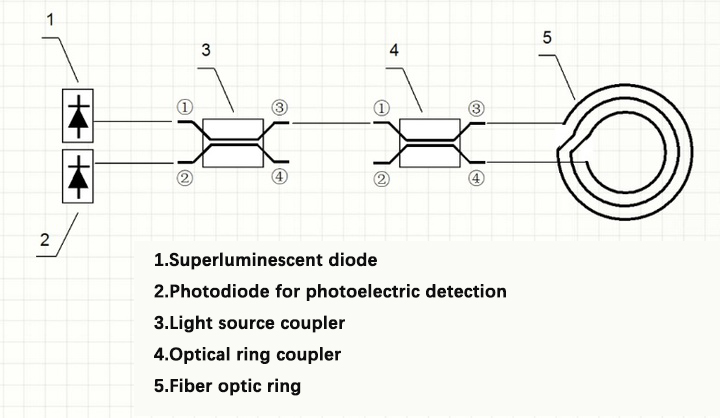Principle and classification of fog
(1)principle
The principle of fog is called Sagnac effect in physics. In a closed light path, two beams of light from the same light source will be interfered when they are converged to the same detection point. If the closed light path has rotation relative to the inertial space, the beam propagating in the positive and negative directions will produce a light path difference, which is proportional to the velocity of the upper rotation angle. The rotation angle velocity is calculated by using the phase difference measured by photoelectric detector.

From the formula, the longer the fiber length, the larger the optical walking radius, the shorter the optical wavelength. The more prominent the interference effect is. So the more significant the volume of fog, the higher the precision. Sagnac effect is essentially a relativistic effect, which is very important for the design of moisture.
The principle of fog is that a beam of light is sent out from the photoelectric tube and passes through the coupler (one end enters three stops). Two beams enter the ring in different directions through the ring and then return around one circle for coherent superposition. The light returned returns to the LED and detects the intensity through the LED. The principle of fog seems simple, but the most important thing is how to eliminate the factors that affect the optical path of two beams—a fundamental problem to be fog.

Principle of fiber optic gyroscope
(2)classification
According to the working principle, fiber optic gyroscopes can be divided into interferometric fiber optic gyroscope (I-FOG), resonant fiber optic gyroscope (R-FOG), and stimulated Brillouin scattering fiber optic gyroscope (B-FOG). At present, the most mature fiber optic gyroscope is the interferometric fiber optic gyroscope (the first generation fiber optic gyroscope), which is widely used. It uses a multi-turn fiber coil to enhance the Sagnac effect. On the other hand, a double beam ring interferometer composed of a multi-turn single-mode fiber coil can provide high precision, which will make the whole structure more complex.
According to the loop type, fog can be divided into open-loop mist and closed-loop FOG. The open-loop fiber optic gyroscope (Ogg) has the advantages of simple structure, low price, high reliability, and low power consumption. On the other hand, the disadvantages of Ogg are poor input-output linearity and a small dynamic range. Therefore, it is mainly used as an angle sensor. The basic structure of the open-loop IFOG is a ring double-beam interferometer. Consequently, it is used primarily in the situation of low precision and small volume.
Performance index of fog
Fog is mainly used to measure angular velocity, and any measurement is an error.
(1)noise
The noise mechanism of fog is mainly concentrated in the optical or photoelectric detection part, which determines the minimum detectable sensitivity of moisture. In fiber-optic gyroscope (FOG), the parameter characterizing the output white noise of angular rate is the random walk coefficient of the detection bandwidth. In the case of only white noise, the definition of random walk coefficient can be simplified as the ratio of the measured bias stability to the square root of the detection bandwidth in a particular bandwidth

If there are other types of noise or drift, we usually use Allan’s analysis of variance to get the random walk coefficient by a proper method.
(2)Zero drift
Angle calculation is needed when using fog. The angle is obtained by angular velocity integration. Unfortunately, the drift is accumulated after a long time, and the error is getting bigger and bigger. Generally speaking, for the fast response application (short term), noise significantly influences the system. Still, for navigation application (long-term), zero drift has a significant influence on the system.
(3)Scale factor (scale factor)
The smaller the scale factor error is, the more accurate the measurement result is.
Beijing Rofea Optoelectronics Co., Ltd. located in China’s “Silicon Valley” – Beijing Zhongguancun, is a high-tech enterprise dedicated to serving domestic and foreign research institutions, research institutes, universities and enterprise scientific research personnel. Our company is mainly engaged in the independent research and development, design, manufacturing, sales of optoelectronic products, and provides innovative solutions and professional, personalized services for scientific researchers and industrial engineers. After years of independent innovation, it has formed a rich and perfect series of photoelectric products, which are widely used in municipal, military, transportation, electric power, finance, education, medical and other industries.
We are looking forward to cooperation with you!
Post time: May-04-2023





